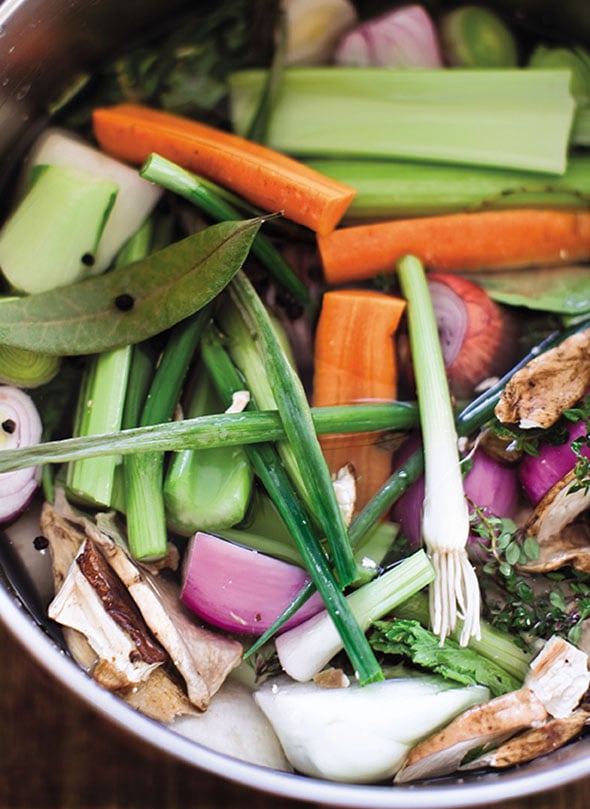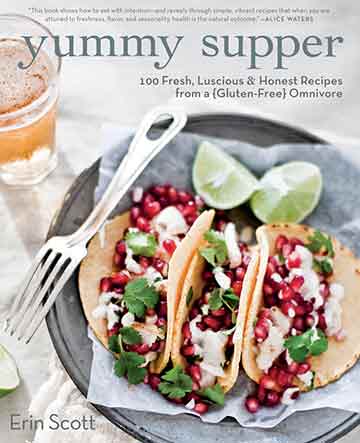
If you collect vegetable scraps throughout the week, you’ll find yourself with more than enough materials to make this sumptuous vegetable broth recipe come Sunday.–Erin Scott
LC Guilty Conscience Note
Do you get clobbered by a guilty conscience each time you let vegetables languish in the fridge? Yeah, us too. “Even when I toss perfectly good veggie scraps into the compost bin, I feel a tug at my conscience telling me the act is wrong,” says the author of this lovely, if loosely defined, vegetable broth recipe. Gah. It’s like she can read our minds. No more guilt, though. Not with this recipe.

Vegetable Broth
Ingredients
- Veggie scraps, such as tough green ends of leeks, bok choy, broccoli florets, turnips and their greens, a wayward carrot, a lonely celery rib, extra onion half, etc. (Avoid using carrot tops in your broth–We think they impart a bitter flavor.)
- Bay leaf
- A few dozen peppercorns
- Sea salt
- A few garlic cloves or shallot
- Herbs of your choosing
- Parmesan rind, (optional)
- Water
Instructions
- Rinse your veggie scraps and toss them into a stock pot. Add the bay leaf, peppercorns, salt, maybe a few cloves of garlic or a shallot, any extra herbs you’ve got lying around, and maybe a rind of Parmesan, if you want. (You can veer from the recipe and use practically anything you want.) Cover everything with plenty of water. Bring the liquid to a boil, then turn the heat down to achieve a gentle simmer. Partially cover the pot and watch your scraps turn into nourishment after a few hours of simmering.
- When the vegetable broth is infused with flavor, turn off the heat and let the liquid cool a bit. Taste and adjust the seasoning, if desired. Use a slotted spoon to scoop the used vegetables right into the compost bin and strain the broth through a fine mesh strainer.
- Use your vegetable broth to make risottos, soups, stews—any recipe you crave. You can stick the broth in lidded containers or resealable plastic bags and stash in the fridge for up to several days or toss it in the freezer until you need it.

Explore More with AI
Nutrition
Nutrition information is automatically calculated, so should only be used as an approximation.
Recipe Testers’ Reviews
I don’t know why I don’t make this vegetable broth every week. I know there are all sorts of vegetable peelings and trimmings going into the garbage. I know I need stock all the time. And I’ve known how to make vegetable stock for years! The problem is that I only think about it when a recipe calls for it and then it’s too late, so I go with the commercial variety. This recipe is so easy and takes no time at all. Just gather the ingredients you’ve been collecting in your fridge, throw them in a pot of water, and simmer for 2 hours. I used scraps of leek, zucchini, broccoli stems, some slightly aged carrots, celery stalks with their tops, and small amounts of basil, rosemary, thyme, oregano, and chive which I harvested from my terrace pots. My yield from this recipe was 6 cups. I haven’t done anything with the stock yet and most of it’s in my freezer. However, I do see some lovely soups and risottos in my future. What a great way to make some deliciously useful stock without any strange additives and save some money at the same time! I’m pledging to make my own vegetable stock every week or so in time for the holidays when I know I’ll need a small ocean of stock.
I like to see a recipe confirming or suggesting what I intuitively do, giving me confirmation that I am not being silly frugal in my kitchen. One of the reasons I like making vegetable broth is that I’ve only found one brand of store-prepared broth that’s not too sweet. The major failing with most packaged vegetable broths is that they rely too much on onions and carrots and other root vegetables. I stash the excess celery stalks, Parmesan rinds, and leek tops in my freezer for use in chicken or vegetable broth. Since I was using leeks this week, I had several sections of light green leeks saved from a recipe that only wanted the white portion, a half quart celery stalks and leaves, nice tops from some kohlrabi, and half a dozen Parmesan rinds. I’d been saving them to make a broth of just Parmesan, but I thought this combination would work nicely with garlic, shallots, and bay. A teaspoon of kosher salt went in before I remembered to use sea salt, but no harm done, and I used a hefty 1/2 tablespoon of a mixed peppercorn blend. If I didn’t already have a specific soup in mind I probably would have added parsley, lemongrass, or thyme, as I do in my chicken stock. I brought it to boil in a tall pot, reduced it to a simmer, and set it on the back of the stove for a bit over 2 hours. Then I strained it, cooled it, and refrigerated it. Once it’s chilled thoroughly, I skimmed off a little fat—from the Parmesan, I believe.
I realize this is mostly a method rather than a recipe—and that’s the brilliance behind it. You can do this yourself with very little effort and lots of choices that give you total control. (You could add dry mushrooms for a heartier flavor.) Next thing you know, you’ll be doing a court bouillon in your sleep!
How come I never thought of this? I use leftover turkey, chicken, and beef parts to make those broths, but for some reason I’ve never made my own vegetable broth. This recipe was so easy and I would think it would be great to make in the crockpot, too—I will have to try that. And so tasty! I used a little bit of a wide variety of vegetables because I had so many left over veggies in the house and we were getting ready to leave for a few days. Lots of carrots, celery, peppers, haricot verts, mushrooms, and pea pods as well as a few tomatoes that needed to be used. I also cut up 3 onions that were not scraps. I used garlic but no shallots. My fresh herbs have been hanging on a long time this year and thriving so I threw in a bunch of basil, oregano, and parsley. This broth is so yummy I will never buy store broth again! It will be too easy to keep a bag marked scraps in my freezer and just freeze scraps until I have enough to do this again. Just as the recipe says, perfect for soups, risotto, rice…just using such rich, delicious broth with will make any recipe even better. Love this one!
I’ve been doing a version of this vegetable broth for years. I freeze the stock and use it in place of chicken stock in most things. One trick I learned was to take all the scraps, put them in a gallon-size heavy-duty freezer bag, and I add to this bag all week long. Then when it’s time to make the stock, I poke small holes with a sharp knife in the bottom of the bag—about a dozen of them. I then gently lower the bag into room temperature water and bring gently to a simmer. When my stock is well infused, I gently lift the bag out slowly and it drains out all the stock, leaving behind all the vegetable bits eliminating the straining step. Super easy and delicious.













Interesting about the potato peels. I think I would peel with a knife and make thicker peels that I do with a vegtable peeler. But I guess they should be left out of the vegtable broth.
Yeah, I would leave them out of the broth, JuneC. Love your trick of making them thicker for crisps, though!
David, thekitchn.com just did an article on using potato peels as a snack. I tried it and it’s a tasty frugal tip. Just remember to give your potato a good scrub before peeling. Fry them up and salt and pepper them or get fancy with some sour cream.
Ann, I have a recipe in my cookbook for deep-fried herbed potato peels. The Lee Bros., who blurbed the book, loved them. In fact, sometimes I make a dish with potatoes just so I can have the skins to fry up!
No mention has been made of potato peelings, can/should these be used?
June, I personally don’t use them. My concern is they can cloud the broth and make it starchy. I think they go best in the compost pile. Anyone else think differently?